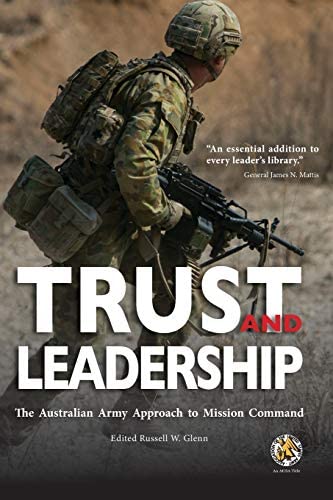Trust and Leadership: The Australian Army Approach to Mission Command serves as an answer to the philosophy that is mission command.
Often junior officers are recommended multiple texts to understand mission command, but it can be difficult to find relatable and readily packaged information that is directly relevant to the Australian command context. Dr Russell W. Glenn, a US Army and Persian Gulf War veteran, stitches together a series of perspectives on mission command and its application from World War II, Vietnam and Somalia through to recent conflicts in Iraq and Afghanistan.
The book also examines the application of mission command outside of conflicts. This includes humanitarian operations, such as the Queensland National Emergency 2010-11, and day-to-day operations in an Australian Army Combat Brigade.
After a foreword from LTGEN L.D Holder, USA (retd) and General Sir Peter Cosgrove, Glenn begins the book by acknowledging that “although the concept of mission command is straightforward, employing it has been difficult for most Western militaries.” This acknowledgement will ring true for many junior officers who feel similarly when attempting to apply the concept of mission command in practice and who must often rely upon orders and doctrine to guide them.
Each chapter is written by a different expert author; including academics and commanders (and most often people who are/were both). The range of authors gives an authenticity to the book, allowing each to assess their context separately and make deductions without influence from what precedes. This makes it an interesting book to read at every new chapter.
To that point, this book can be read in two ways. You may ‘choose your own adventure’ and read portions of the text which address the application of mission command in a specific context which most appeals to you. Alternately, you can read the whole text sequentially, and benefit from the range situations where mission command has been applied and the sum of the parts to compare and broaden your overall knowledge of mission command.
A chapter that particularly resonated with me was written by Brigadier Chris Smith; who has previously spoken on mission command to the Centre for Australian Army Leadership podcast series. Here he speaks about commanding the 2nd Battalion, the Royal Australian Regiment Battle Group in Afghanistan in 2011. He explores the necessity of balancing mission command and responsibility, and how this can become confused.
Smith demonstrates this confusion through an example from his time in Afghanistan where there was unacceptable risk to the safety and security of his team. Soldiers stood within range of small arms fire without body armour or their weapons within arm’s reach. Additionally, they stood in groups of up to twenty – a lucrative target for adversaries. The autonomy of these soldiers became ‘false’ as they did what they liked rather than what they ought to – which Smith calls ‘true’ autonomy.
This behaviour was a result of a series of factors, including a lack of supervision and superior commanders failing to emphasise to subordinate commanders their responsibility for the safety and security of the soldiers.
His chapter acknowledges the difficulty of remembering and applying the basics of leadership when commanding geographically dispersed teams, and the toll command takes on leaders and their ability to influence subordinates. Smith alerts readers to “the potential to confuse mission command for something more akin to ‘hands off’ leadership” which is “to misapply it.”
Smith explains, “the dispersed and decentralised character of the battle group’s operations did not obviate my officers, non-commissioned officers, or my responsibility to see the proper execution of my intentions.” He sought to correct the team and their actions by applying mission command in his headquarters so that he was able to travel to outposts to appraise the teams and explain how their contribution had an appreciable effect on overall mission success. He linked mission command to the responsibility of commanders to ensure the execution of their intent is met.
I highly recommend Trust and Mission Command: The Australian Army Approach to Mission Command. Glenn has pulled together a tapestry of rich insights, where each chapter serves as a standalone text in its own merit. All commanders, even down to the section commanders, can benefit from this book.
About the Author: Lieutenant Emma Watson is a junior officer of the 11th Engineer Regiment. Follow her on Twitter.

